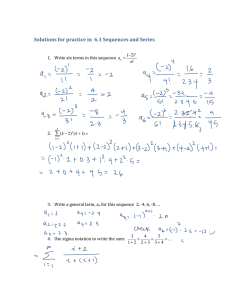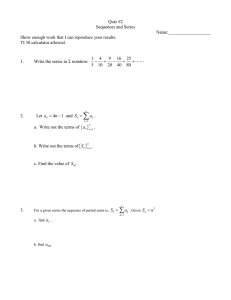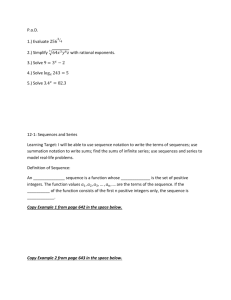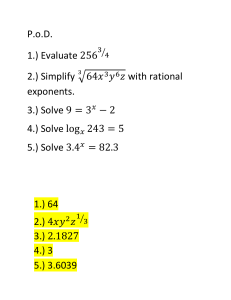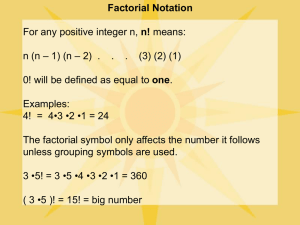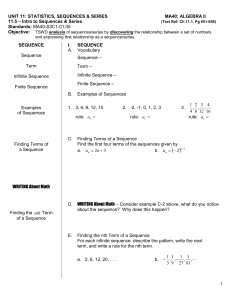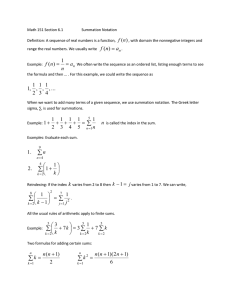CHAPTER 9: SEQUENCES AND SERIES 9.1Sequencesb February 09, 2013
advertisement
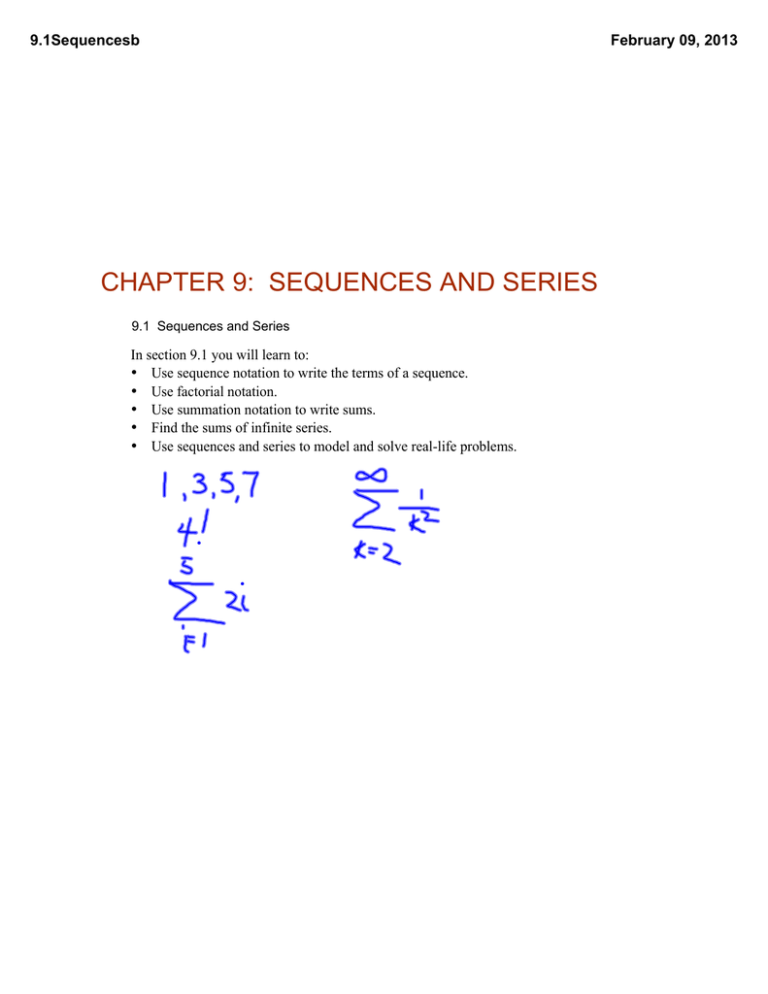
9.1Sequencesb CHAPTER 9: SEQUENCES AND SERIES 9.1 Sequences and Series In section 9.1 you will learn to: • Use sequence notation to write the terms of a sequence. • Use factorial notation. • Use summation notation to write sums. • Find the sums of infinite series. • Use sequences and series to model and solve real-life problems. February 09, 2013 9.1Sequencesb February 09, 2013 What is a sequence? Finite: 1, 2, 4, 8 Infinite: 1, 3, 5, 7, ..., 2n-1, ... A sequence is a function with the domain a subset of the natural numbers. 1 2 3 9.1Sequencesb Example 1: a) Write the first four terms of this sequence: an= n2 + 1 b) Write the first four terms of this sequence: bn = (-1)n+1(10n + 3) February 09, 2013 9.1Sequencesb February 09, 2013 Example 2: Find a formula for the nth term in each of these sequences, then use the formula to find the 10th term. a) 2, 4, 5, 8, 10, ... b) 3, -6, 12, -24, ... 9.1Sequencesb February 09, 2013 Some sequences are defined recursively. One or more initial terms are given and subsequent terms are defined using the previous terms. Example 3: a1 = 2 an = 3an-1 + 1 for each n > 1 What are the first four terms? 9.1Sequencesb February 09, 2013 Example 4: The Fibonacci Sequence a1 = 1 a2 = 1 ak = ak-1 + ak-2 List five terms: 9.1Sequencesb February 09, 2013 Factorials are often used in sequence definitions. We define n factorial (written n!) to be: n! = 1⋅2⋅3⋅...⋅(n-1)⋅n 4! = 0! is defined to be 0! = 1 Example 5: Evaluate these expressions: a) 8! 2!⋅6! b) (n+1)! (n-1)! It is often convenient to recognize the factorials of the first five or six natural numbers. 9.1Sequencesb February 09, 2013 Example 6: Write the first four terms of these sequences: a) an = 1 n! b) bn = n (n+2)! 9.1Sequencesb February 09, 2013 A series is the sum of the terms in a sequence. The sum of the first n terms of a sequence is the nth partial sum Sn. The 5th partial sum of the sequence of odd numbers is S5 = For an arbitrary sequence a1, a2, a3, ... , a100 , the corresponding series is a1+ a2+ a3+ ... + a100. We abbreviate this sum using the Greek letter Σ (sigma): 100 ∑ai = a1+ a2+ a3+ ... + a100. i=1 The subscript i=1 and superscript 100 written above and below sign indicate which terms begin and end the series. The index i is not unique, but is sometimes replaced using j, k, etc. Express 32+ 42 + 52 + 62 using the sigma. 9.1Sequencesb February 09, 2013 Example 7: Find the sum of these series by adding the terms: 5 a) ∑ 2 (1+3j) b) j=1 ∑ k=0 Use summation notation to abbreviate this series: 1 1⋅2 + 1 2⋅3 + 1 3⋅4 + + ... + 1 99⋅100 (-1)k 2k 9.1Sequencesb February 09, 2013 Example 8: You’re a clever student. You’ve decided to save your money for a trip to Europe, but it will be expensive. You’ve decided to open a savings account today with $1. You plan to add more each day, 7 days a week, by depositing one more dollar each day than you did the previous day. Use summation notation to express the total amount you will have contributed at the end of one year: 9.1Sequencesb February 09, 2013
